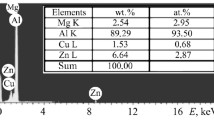We consider the specific features of generation of acoustic emission caused by the fatigue fracture of thermally strengthened 1201-T aluminum alloy. Based on the metallographic and fractographic investigations and analysis of typical signals, we establish that this alloy is destroyed by the brittle-ductile mechanism. The character of acoustic-emission radiation depends on the alloy microstructure and mechanical properties, and the area of the formed defect is proportional to the sum of amplitudes of the recorded signals. The passage from the initiation of a fatigue crack to its stable propagation is accompanied by a sharp jump of the acoustic-emission activity.





Similar content being viewed by others
References
V. R. Skal’s’kyi and P. M. Koval’, Acoustic Emission in the Course of Fracture of Materials, Articles, and Structures [in Ukrainian], SPOLOM, Lviv (2005).
J. C. Duke and R. E. Green, “Simultaneous monitoring of acoustic emission and ultrasonic attenuation during fatigue of 7075 aluminum,” Int. J. Fatigue, 1, 125–132 (1979).
T. M. Roberts and М. Talebzadeh, “Acoustic-emission monitoring of fatigue crack propagation,” J. Construct. Steel Res., 59, 695–712 (2003).
A. Berkovits and D. Fang, “Study of fatigue crack characteristics by acoustic emission,” Eng. Fract. Mech., 51, 401–409 (1995).
D. Fang and A. Berkovits, “Fatigue design model based on damage mechanisms revealed by acoustic-emission measurements,” Trans. ASME, 117, 200–208 (1995).
M. Huang, L. Jiang, P. K. Liaw, et al., “Using acoustic emission in fatigue and fracture materials research,” JOM J. Minerals, Metals Mater. Soc., 50, No. 11, 1–12 (1998).
D. O. Harris and H. L. Dunegan, “Continuous monitoring of fatigue-crack growth by acoustic-emission techniques,” Exp. Mech., 14, No. 2, 71–81 (1974).
T. C. Lindley, I. G. Palmer, and C. E. Richards, “Acoustic-emission monitoring of fatigue crack growth,” Mater. Sci. Eng., 32, 1–15 (1978).
C. B. Scruby, G. R. Baldwin, and K. A. Stacey, “Characterization of fatigue crack extension by quantitative acoustic emission,” Int. J. Fract., 28, No. 4, 201–222 (1985).
S. Grondel, C. Delebarre, J. Assaad, et. al., “Fatigue crack monitoring of riveted aluminum strap joints by Lamb wave analysis and acoustic-emission measurement techniques,” NDT & E Int., 35, 137–146 (2002).
Methodical Instructions. Strength Analysis and Tests in Machine Building. Methods of the Mechanical Tests of Metals. Determination of the Characteristics of Resistance to Crack Propagation (Crack Resistance) under Cyclic Loading [in Russian], Gos. Komitet Standartov SSSR, L’vov (1979).
M. S. Miller and J. P. Gallagher, “An analysis of several fatigue crack growth rate description,” in: Fatigue Crack Growth Measurement and Data Analysis, Am. Soc. Test. Mater. (1981), pp. 205–251.
V. R. Skalsky and I. M. Lyasota, “Estimation of the heat-affected zone for the electron-beam welding of plates,” Mater. Sci., 46, No. 1, 115–123 (2010).
V. V. Panasyuk (editor), Fracture Mechanics and Strength of Materials: Handbook [in Russian], Vol. 4: O. N. Romaniv, S. Ya. Yarema, G. N. Nikiforchin, et al., Fatigue and Cyclic Crack Resistance of Structural Materials, Naukova Dumka, Kiev (1990).
W. W. Gerberich, D. G. Alteridge, and J. E. Lessar, “Acoustic-emission investigation of microscopic ductile fracture,” Met. Trans., A6, No. 2, 797–801 (1975).
I. C. Radon and A. A. Pollock, “Acoustic emission and energy transfer during crack propagation,” Eng. Fract. Mech., 4, No. 2, 295–310 (1972).
N. M. Astaf’eva, “Wavelet analysis: theoretical foundations and examples of application,” Usp. Fiz. Nauk, 166, No. 11, 1145–1170 (1996).
V. R. Skal’skii, S. I. Builo, and E. M. Stankevich, “A criterion for the estimation of glass brittle fracture by acoustic-emission signals,” Defektoskopiya, No. 5, 26–34 (2012).
V. R. Skal’s’kyi, L. R. Botvina, and O. M. Stankevych, “Diagnostics of the fracture mechanisms of 38KhN3MFA steel by the wavelet transform of acoustic-emission signals,” Tekhn. Diagn. Nerazrush. Kontrol’, No. 3, 12–17 (2011).
Vallen Systeme: The Acoustic Emission Company [Virtual Resource], http://www.vallen.de.
Author information
Authors and Affiliations
Corresponding author
Additional information
Translated from Fizyko-Khimichna Mekhanika Materialiv, Vol. 48, No. 5, pp. 110–116, September–October, 2012.
Rights and permissions
About this article
Cite this article
Skal’s’kyi, V.R., Lyasota, I.M. & Stankevych, O.M. Acoustic-emission diagnostics of the initiation of fatigue fracture of 1201-T aluminum alloy. Mater Sci 48, 680–686 (2013). https://doi.org/10.1007/s11003-013-9554-x
Received:
Published:
Issue Date:
DOI: https://doi.org/10.1007/s11003-013-9554-x




